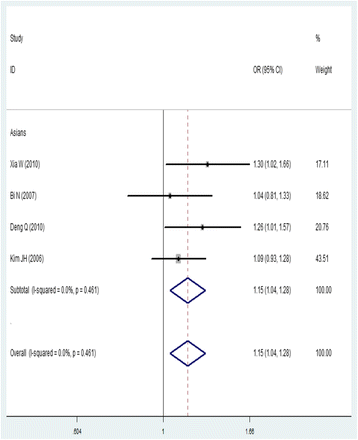Association between ATM gene polymorphisms, lung cancer susceptibility and radiation-induced pneumonitis: a meta-analysis
- PMID: 29246212
- PMCID: PMC5731205
- DOI: 10.1186/s12890-017-0555-7
Association between ATM gene polymorphisms, lung cancer susceptibility and radiation-induced pneumonitis: a meta-analysis
Abstract
Background: Previous studies have suggested that DNA double-strand break (DSB) repair is an important protective pathway after damage. The ataxia telangiectasia mutated (ATM) gene plays an important role in the DNA DSB repair pathway. DNA damage is a major cytotoxic effect that can be caused by radiation, and the ability to repair DNA after damage varies among different tissues. Impaired DNA repair pathways are associated with high sensitivity to radiation exposure. Hence, ATM gene polymorphisms are thought to influence the risk of cancer and radiation-induced pneumonitis (RP) risk in cancer patients treated with radiotherapy. However, the results of previous studies are inconsistent. We therefore conducted this comprehensive meta-analysis.
Methods: A systematic literature search was performed in the PubMed, Embase, China National Knowledge Internet (CNKI) and Wanfang databases to identify studies that investigated the association between the ATM gene polymorphisms and both lung cancer and RP radiotherapy-treated lung cancer (the last search was conducted on Dec.10, 2015). The odds ratio (OR) and 95% confidence interval (CI) were used to investigate the strength of these relationships. Funnel plots and Begg's and Egger's tests were conducted to assess the publication bias. All analyses were performed in STATA 13.0 software.
Results: Ten eligible case-control studies (4731 cases and 5142 controls) on lung cancer susceptibility and four (192 cases and 772 controls) on RP risk were included. The results of the overall and subgroup analyses indicated that in the ATM gene, the rs189037 (-111G > A, -4519G > A), rs664677 (44831C > T, 49238C > T) and rs664143 (131,717 T > G) polymorphisms were significantly associated with lung cancer susceptibility (OR = 1.21, 95% CI = 1.04-1.39, P = 0.01; OR = 1.26, 95% CI = 1.06-1.49, P = 0.01; OR = 1.43, 95% CI = 1.15-1.78, P < 0.01). Additionally, the rs189037 variant was significantly associated with RP risk (OR = 1.74, 95% CI = 1.02-2.97, P = 0.04). No publication bias was found in the funnel plots, Begg's tests or Egger's tests.
Conclusions: The results indicate that the ATM rs189037, rs664677 and rs664143 gene polymorphisms are risk factors for lung cancer, while the ATM rs189037 variant was significantly associated with RP risk.
Keywords: Ataxia telangiectasia mutated; Lung cancer; Meta-analysis; Polymorphism; Radiation-induced pneumonitis.
Conflict of interest statement
Ethics approval and consent to participate
Not applicable.
Consent for publication
Not applicable.
Competing interests
The authors declare that they have no competing interests.
Publisher’s Note
Springer Nature remains neutral with regard to jurisdictional claims in published maps and institutional affiliations.
Figures





References
Publication types
MeSH terms
Substances
Grants and funding
LinkOut - more resources
Full Text Sources
Other Literature Sources
Medical
Research Materials
Miscellaneous

